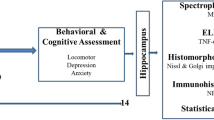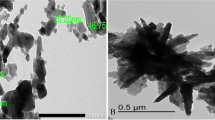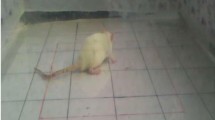Abstract
The aim of the current study was to determine protective effects of betaine on depressive-like behaviors in zinc oxide nanoparticles (ZnO NPs) exposed mice. Forty male mice randomly allocated into four experimental groups. Group 1 kept as control and groups 2–4 received oral administration of betaine (30 mg/kg), ZnO NPs (600 mg/kg), and ZnO NPs (600 mg/kg) 1 h after pre-administration of betaine (30 mg/kg) for 7 days, respectively. Then, forced swimming test (FST), tail suspension test (TST), open field test (OFT), and rotarod tests were done. Furthermore, serum malondialdehyde (MDA), superoxide dismutase (SOD), glutathione peroxidase (GPx), and total antioxidant capacity (TAC) levels were determined. Hippocampal tissue samples were collected for histopathological assessment. According to the results, treatment with ZnO NPs significantly increased immobility time in the FST and TST (P<0.05). Betaine significantly decreased immobility time in the FST and TST (P<0.05). Pretreatment with betaine significantly decreased ZnO NPs-induced alterations in the FST and TST (P<0.05). The duration of staying on the rotarod and the numbers of crossings in the OFT significantly decreased in the mice that received ZnO NPs (P<0.05). These results were significantly improved in betaine+ZnO NPs treated mice as compared to the ZnO NPs group (P<0.05). Treatment with ZnO NPs significantly increased serum MDA level while decreased SOD and GPx compared to the control group (P<0.05). These changes were effectively ameliorated by pretreatment with betaine compared to the ZnO NPs group (P<0.05). No significant effect on serum TAC level was observed in all groups (P˃0.05). Administration of ZnO NPs decreased the thickness of hippocampus and pyramidal neurons in the hippocampal dentate gyrus (DG) and CA1 regions were sparsely arranged. Pretreatment with betaine caused an improvement in the histological features of the hippocampus when compared with ZnO NPs-treated mice. Taken together, these results suggest that betaine has protective role against ZnO NPs-induced toxicity in mice.










Similar content being viewed by others
References
Yaqub A, Faheem I, Anjum KM, Ditta SA, Yousaf MZ, Tanvir F, Raza C (2020) Neurotoxicity of ZnO nanoparticles and associated motor function deficits in mice. Appl Nanosci 10(1):177–185
Ansar S, Abudawood M, Hamed SS, Aleem MM (2017) Exposure to zinc oxide nanoparticles induces neurotoxicity and proinflammatory response: amelioration by hesperidin. Biol Trace Elem Res 175(2):360–366
Jarosz M, Olbert M, Wyszogrodzka G, Młyniec K, Librowski T (2017) Antioxidant and anti-inflammatory effects of zinc. Zinc-dependent NF-κB signaling. Inflammopharmacology 25(1):11–24
Doane TL, Burda C (2012) The unique role of nanoparticles in nanomedicine: imaging, drug delivery and therapy. Chem Soc Rev 41(7):2885–2911
Tian L, Lin B, Wu L, Li K, Liu H, Yan J, Liu X, Xi Z (2015) Neurotoxicity induced by zinc oxide nanoparticles: age-related differences and interaction. Sci Rep 5:16117. https://doi.org/10.1038/srep16117
Yang Z, Liu ZW, Allaker RP, Reip P, Oxford J, Ahmad Z, Ren G (2010) A review of nanoparticle functionality and toxicity on the central nervous system. J R Soc Interface 7:S411–S422
Vandebriel RJ, De Jong WH (2012) A review of mammalian toxicity of ZnO nanoparticles. Nanotechnol Sci Appl 5:61–71
Xiaoli F, Junrong W, Xuan L, Yanli Z, Limin W, Jia L, Longquan S (2017) Prenatal exposure to nanosized zinc oxide in rats: neurotoxicity and postnatal impaired learning and memory ability. Nanomedicine 12(7):777–795
Attia H, Nounou H, Shalaby M (2018) Zinc oxide nanoparticles induced oxidative DNA damage, inflammation and apoptosis in rat’s brain after oral exposure. Toxics 6(2):29. https://doi.org/10.3390/toxics6020029
Okada Y, Tachibana K, Yanagita S, Takeda K (2013) Prenatal exposure to zinc oxide particles alters monoaminergic neurotransmitter levels in the brain of mouse offspring. J Toxicol Sci 38(3):363–370
Alimohammadi S, Hassanpour S, Moharramnejad S (2019a) Effect of maternal exposure to zinc oxide nanoparticles on reflexive motor behaviors in mice offspring. Int J Pept Res Ther 25(3):1049–1056
Feng X, Chen A, Zhang Y, Wang J, Shao L, Wei L (2015) Central nervous system toxicity of metallic nanoparticles. Int J Nanomedicine 10:4321–4340
Alimohammadi S, Hosseini MS, Behbood L (2019b) Prenatal exposure to zinc oxide nanoparticles can induce depressive-like behaviors in mice offspring. Int J Pept Res Ther 25(1):401–409
Kim DH, Sung B, Kang YJ, Jang JY, Hwang SY, Lee Y, Kim M, Im E, Yoon JH, Kim CM, Chung HY (2014) Anti-inflammatory effects of betaine on AOM/DSS-induced colon tumorigenesis in ICR male mice. Int J Oncol 45(3):1250–1256
Kim SJ, Lee L, Kim JH, Lee TH, Shim I (2013) Antidepressant-like effects of lycii radicis cortex and betaine in the forced swimming test in rats. Biomol Ther 21(1):79–83
Knight LS, Piibe Q, Lambie I, Perkins C, Yancey PH (2017) Betaine in the brain: characterization of betaine uptake, its influence on other osmolytes and its potential role in neuroprotection from osmotic stress. Neurochem Res 42(12):3490–3503
Mijailovic N, Selakovic D, Joksimovic J, Mihailovic V, Katanic J, Jakovljevic V, Nikolic T, Bolevich S, Zivkovic V, Pantic M, Rosic G (2019) The anxiolytic effects of atorvastatin and simvastatin on dietary-induced increase in homocysteine levels in rats. Mol Cell Biochem 452(1):199–217
Bhatia P, Singh N (2015) Homocysteine excess: delineating the possible mechanism of neurotoxicity and depression. Fundam Clin Pharmacol 29(6):522–528
Kumar M, Modi M, Sandhir R (2017) Hydrogen sulfide attenuates homocysteine-induced cognitive deficits and neurochemical alterations by improving endogenous hydrogen sulfide levels. Biofactors 43(3):434–450
Kunisawa K, Kido K, Nakashima N, Matsukura T, Nabeshima T, Hiramatsu M (2017) Betaine attenuates memory impairment after water-immersion restraint stress and is regulated by the GABAergic neuronal system in the hippocampus. Eur J Pharmacol 796:122–130
Lin JC, Lee MY, Chan MH, Chen YC, Chen HH (2016) Betaine enhances antidepressant-like, but blocks psychotomimetic effects of ketamine in mice. Psychopharmacology 233(17):3223–3235
Ohnishi T, Balan S, Toyoshima M, Maekawa M, Ohba H, Watanabe A, Iwayama Y, Fujita Y, Tan Y, Hisano Y, Shimamoto-Mitsuyama C (2019) Investigation of betaine as a novel psychotherapeutic for schizophrenia. EBioMedicine 45:432–446
Hassanpour S, Rezaei H, Razavi SM (2020) Anti-nociceptive and antioxidant activity of betaine on formalin-and writhing tests induced pain in mice. Behav Brain Res 390:112699
Zimmermann M (1983) Ethical guidelines for investigations of experimental pain in conscious animals. Pain 16(2):109–110
Zahra J, Iqbal S, Zahra K, Javed Z, Shad MA, Akbar A, Ashiq MN, Iqbal F (2017) Effect of variable doses of zinc oxide nanoparticles on male albino mice behavior. Neurochem Res 42(2):439–445
Nasehi M, Mohammadi-Mahdiabadi-Hasani MH, Ebrahimi-Ghiri M, Zarrindast MR (2019) Additive interaction between scopolamine and nitric oxide agents on immobility in the forced swim test but not exploratory activity in the hole-board. Psychopharmacology 236(11):3353–3362
Cryan JF, Mombereau C, Vassout A (2005) The tail suspension test as a model for assessing antidepressant activity: review of pharmacological and genetic studies in mice. Neurosci Biobehav Rev 29(4-5):571–625
Steru L, Chermat R, Thierry B, Simon P (1985) The tail suspension test: a new method for screening antidepressants in mice. Psychopharmacology 85(3):367–370
Donato F, de Gomes MG, Goes AT, Borges Filho C, Del Fabbro L, Antunes MS, Souza LC, Boeira SP, Jesse CR (2014) Hesperidin exerts antidepressant-like effects in acute and chronic treatments in mice: possible role of L-arginine-NO-cGMP pathway and BDNF levels. Brain Res Bull 104:19–26
Jürgensen S, DalBó S, Angers P, Santos ARS, Ribeiro-do-Valle RM (2005) Involvement of 5HT2 receptors in the antinociceptive effect of Uncaria tomentosa. Pharmacol Biochem Behav 8:466–477
Sayeli V, Nadipelly J, Kadhirvelu P, Cheriyan BV, Shanmugasundaram J, Subramanian V (2019) Antinociceptive effect of flavonol and a few structurally related dimethoxy flavonols in mice. Inflammopharmacol 1–13
Allahmoradi M, Alimohammadi S, Cheraghi H (2019) Protective effect of Cynara scolymus L. on blood biochemical parameters and liver histopathological changes in phenylhydrazine-induced hemolytic anemia in rats. Pharm. Biomed Res 5(4):53–62
Mohammadali S, Heshami N, Komaki A, Tayebinia H, Abbasi Oshaghi E, Karimi J, Hashemnia M, Khodadadi I (2020) Dill tablet and Ocimum basilicum aqueous extract: promising therapeutic agents for improving cognitive deficit in hypercholesterolemic rats. J Food Biochem 44(12):e13485
Wen S, Li Y, Shen X, Wang Z, Zhang K, Zhang J, Mei X (2021) Protective effects of zinc on spinal cord injury. J Mol Neurosci 23:1–8. https://doi.org/10.1007/s12031-021-01859-x
Shamohammadi M, Pooyanmehr M, Maleki A, Alimohammadi S (2021) Evaluation of protective and immunomodulatory effects of hydroalcoholic extract of Scrophularia striata on silver nanoparticle-induced toxicity in male rats. Arch. Adv Biosci 12(1):7–17. https://doi.org/10.22037/aab.v12i1.32832
Kalpana VN, Devi Rajeswari V (2018) A review on green synthesis, biomedical applications, and toxicity studies of ZnO NPs. Bioinorg Chem Appl 2018:1–12. https://doi.org/10.1155/2018/3569758
Wang Z, Zhang C, Huang F, Liu X, Wang Z, Yan B (2021) Breakthrough of ZrO2 nanoparticles into fetal brains depends on developmental stage of maternal placental barrier and fetal blood-brain-barrier. J Hazard Mater 402:123563. https://doi.org/10.1016/j.jhazmat.2020.123563
Choi J, Kim H, Kim P, Jo E, Kim HM, Lee MY, Jin SM, Park K (2015) Toxicity of zinc oxide nanoparticles in rats treated by two different routes: single intravenous injection and single oral administration. J Toxicol Environ Health Part A 78(4):226–243
Liu WC, Guo Y, An LL, Zhao ZH (2021) Protective effects of dietary betaine on intestinal barrier function and cecal microbial community in indigenous broiler chickens exposed to high temperature environment. Environ Sci Pollut Res 28:10860–10871
Khodadadeh A, Hassanpour S, Akbari G (2020) Effects of hesperidin during pregnancy on antidepressant-like behaviour in postpartum mice. Iran J Vet Med 14(3):261–270
Haramipour P, Asghari A, Hassanpour S, Jahandideh A (2021) Anti-depressant effect of betaine mediates via nitrergic and serotoninergic systems in ovariectomized mice. Arch Razi Inst 76(5):1097–1107
de Souza JM, de Oliveira MB, Guimarães AT, de Lima Rodrigues AS, Chagas TQ, Rocha TL, Malafaia G (2018) Zinc oxide nanoparticles in predicted environmentally relevant concentrations leading to behavioral impairments in male Swiss mice. Sci Total Environ 613:653–662
Han D, Tian Y, Zhang T, Ren G, Yang Z (2011) Nano-zinc oxide damages spatial cognition capability via over-enhanced long-term potentiation in hippocampus of Wistar rats. Int J Nanomedicine 6:1453–1461
Xie Y, Wang Y, Zhang T, Ren G, Yang Z (2012) Effects of nanoparticle zinc oxide on spatial cognition and synaptic plasticity in mice with depressive-like behaviors. J Biomed Sci 19:14
Zhao J, Xu L, Zhang T, Ren G, Yang Z (2009) Influences of nanoparticle zinc oxide on acutely isolated rat hippocampal CA3 pyramidal neurons. Neurotoxicology 30(2):220–230
Zhao J, Yao Y, Liu S, Zhang T, Ren G, Yang Z (2012) Involvement of reactive oxygen species and high-voltage-activated calcium currents in nanoparticle zinc oxide-induced cytotoxicity in vitro. J Nanopart Res 14(11):1238
Miwa M, Tsuboi M, Noguchi Y, Enokishima A, Nabeshima T, Hiramatsu M (2011) Effects of betaine on lipopolysaccharide-induced memory impairment in mice and the involvement of GABA transporter 2. J Neuroinflammation 8:153
Kanbak G, Arslan OC, Dokumacioglu A, Kartkaya K, Inal ME (2008) Effects of chronic ethanol consumption on brain synaptosomes and protective role of betaine. Neurochem Res 33:539–544
Zhao G, He F, Wu C, Li P, Li N, Deng J, Zhu G, Ren W, Peng Y (2018) Betaine in inflammation: mechanistic aspects and applications. Front Immunol 9:1070. https://doi.org/10.3389/fimmu.2018.01070
Alirezaei M, Jelodar G, Ghayemi Z (2012) Antioxidant defense of betaine against oxidative stress induced by ethanol in the rat testes. Int J Pept Res Ther 18:239–247
Jelodar G, Javid Z, Sahraian A, Jelodar S (2018) Saffron improved depression and reduced homocysteine level in patients with major depression: a randomized, double-blind study. Avicenna J Phytomed 8(1):43–50
Di Pierro F, Orsi R, Settembre R (2015) Role of betaine in improving the antidepressant effect of S-adenosyl-methionine in patients with mild-to-moderate depression. J Multidiscip Healthc 8:39–45
Alirezaei M, Jelodar G, Ghayemi Z, Khordad Mehr M (2014) Antioxidant and methyl donor effects of betaine versus ethanol-induced oxidative stress in the rat liver. Comp Clin Pathol 23:161–168
Ganesan B, Buddhan S, Anandan R, Sivakumar R, AnbinEzhilan R (2010) Antioxidant defense of betaine against isoprenaline-induced myocardial infarction in rats. Mol Biol Rep 37(3):1319–1327
Alirezaei M, Jelodar G, Niknam P, Ghayemi Z, Nazifi S (2011) Betaine prevents ethanol-induced oxidative stress and reduces total homocysteine in the rat cerebellum. J Physiol Biochem 67:605–612
Ricceri L, De Filippis B, Fuso A, Laviola G (2011) Cholinergic hypofunction in MeCP2-308 mice: beneficial neurobehavioural effects of neonatal choline supplementation. Behav Brain Res 221(2):623–629
Funding
This research was supported by a grant from the Research Council of the Faculty of Veterinary Medicine, Razi University, Iran.
Author information
Authors and Affiliations
Corresponding author
Ethics declarations
Conflict of interest
The authors declare no competing interests.
Additional information
Publisher’s Note
Springer Nature remains neutral with regard to jurisdictional claims in published maps and institutional affiliations.
Rights and permissions
About this article
Cite this article
Jeyhoonabadi, M., Alimoahmmadi, S., Hassanpour, S. et al. Betaine Ameliorates Depressive-Like Behaviors in Zinc Oxide Nanoparticles Exposed Mice. Biol Trace Elem Res 200, 4771–4781 (2022). https://doi.org/10.1007/s12011-021-03068-4
Received:
Accepted:
Published:
Issue Date:
DOI: https://doi.org/10.1007/s12011-021-03068-4




